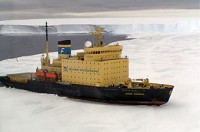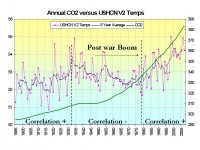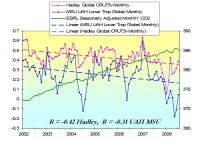
|
Jun 01, 2008
Our Spotless Sun
By Lawrence Solomon, Financial Post
You probably haven’t heard much of Solar Cycle 24, the current cycle that our sun has entered, and I hope you don’t. If Solar Cycle 24 becomes a household term, your lifestyle could be taking a dramatic turn for the worse. That of your children and their children could fare worse still, say some scientists, because Solar Cycle 24 could mark a time of profound long-term change in the climate. As put by geophysicist Philip Chapman, a former NASA astronaut-scientist and former president of the National Space Society, “It is time to put aside the global warming dogma, at least to begin contingency planning about what to do if we are moving into another little ice age.”
The sun, of late, is remarkably free of eruptions: It has lost its spots. By this point in the solar cycle, sunspots would ordinarily have been present in goodly numbers. Today’s spotlessness - what alarms Dr. Chapman and others - may be an anomaly of some kind, and the sun may soon revert to form. But if it doesn[t - and with each passing day, the speculation in the scientific community grows that it will not - we could be entering a new epoch that few would welcome.

This was the case during the Little Ice Age, a period starting in the 15th or 16th century and lasting centuries, says NASA’s Goddard Space Centre, which links the absence of sunspots to the cold that then descended on Earth. During the coldest part of the Little Ice Age, a time known as the Maunder Minimum (named after English astronomer Edward Maunder), astronomers saw only about 50 sunspots over a 30-year period, less than one half of 1% of the sunspots that would normally have been expected. Other Minimums - times of low sunspot activity - also corresponded to times of unusual cold.
During the Little Ice Age, the River Thames froze over, the Dutch developed the ice skate and the great artists of the day learned to love a new genre: the winter landscape.
Glaciers advanced rapidly in Greenland, Iceland, Scandinavia and North America, making vast tracts of land uninhabitable. The Arctic pack ice extended so far south that several reports describe Eskimos landing their kayaks in Scotland. Finland’s population fell by one-third, Iceland’s by half, the Viking colonies in Greenland were abandoned altogether, as were many Inuit communities. The cold in North America spread so far south that, in the winter of 1780, New York Harbor froze, enabling people to walk from Manhattan to Staten Island. Read more here. See also earlier blog on cycle 24 and the significance of its delay here.
May 29, 2008
Cold Irony: Arctic Sea Ice Traps Climate Tour Icebreaker
By Anthony Watts, Watts Up With that
Last year as arctic sea ice melted to record levels, panic set in for many. But then, as the sea ice rebounded and froze again quickly in the 2007/2008 winter, making up for that record loss and reaching heights not seen for several years, many exclaimed that even though the ice areal extent had recovered, this new ice was “thin” and would likely melt again quickly. There were also many news stories about how the Northwest Passage was ice free for the first time “ever”. For example, Backpacker Magazine ran a story saying “The ice is so low that the photos clearly show a viable northwest passage sea route along the coasts of Greenland, Canada, and Alaska.” (Icecap Note: See Dr. Gary Sharp’s view on that here)
Cashing in on the panic that has set in with the help of some climate alarmists, tour operators like Quark Expeditions of Norwalk Connecticut are offering polar expeditions catering to that “see it before it’s gone” travel worry. One of them is in fact a trip though the Northwest Passage on a former Soviet Icebreaker called the Kapitan Khlebnikov which is a massive 24,000 horsepower Polar Class icebreaker capable of carrying 108 passengers in relative luxury through the arctic wilderness.

Walt from Canada, pointed out this story in the Globe and Mail on may 24th in the travel section. It seems the irony of a polar expedition to see such things as record sea ice loss being stopped cold by the very ice that doesn’t exist was not lost on the editors. From the Globe and Mail article:
“I am on the bridge of the massive Russian icebreaker Kapitan Khlebnikov, and the tension is palpable. We have hit ice - thick ice. The ice master studies the mountains of white packed around the ship while the 24,000-horsepower diesel engines work at full throttle to open a path. The ship rises slowly onto the barrier of ice, crushes it and tosses aside blocks the size of small cars as if they were ice cubes in a glass. It creeps ahead a few metres, then comes to a halt, its bow firmly wedged in the ice. After doing this for two days, the ship can go no farther. The ice master confers with the captain, who makes a call to the engine room. The engines are shut down. He turns to those of us watching the drama unfold, and we are shocked by his words: “Now, only nature can help this ship.” We are doomed to drift. What irony. I am a passenger on one of the most powerful icebreakers in the world, travelling through the Northwest Passage - which is supposed to become almost ice-free in a time of global warming, the next shipping route across the top of the world - and here we are, stuck in the ice, engines shut down, bridge deserted. Only time and tide can free us.” What irony indeed. Read Anthony’s full post here.
May 29, 2008
Error Growth Beyond The Hapless Butterfly
By Henk Tennekes, Guest Weblog on Climate Science
In the minds of the general public, the sensitive dependence on initial conditions that many nonlinear systems exhibit is expressed vividly by Ed Lorenz’ description of a butterfly which, merely by flapping its wings, might cause a tornado far away. It is unfortunate that Lorenz’ poetry has been taken too literally, even by scientists. As far as I have been able to determine, Lorenz meant to illustrate error growth caused by data assimilation and initialization errors, not the possible upscale propagation of errors. In my mind, an undetected small-scale disturbance cannot cause an unexpected large-scale event. Even a million Monarch butterflies taking off from their winter roost in Mexico cannot cause a tornado in Kansas. Also, it takes considerable time for small-scale calculation errors to propagate toward the large-scale end of the energy spectrum, especially when, as in all turbulence, the flow is strongly dissipative. Errors that creep in through subtle deficiencies in the codes employed are most effective when they invade the large scales of motion directly. Aliasing between neighboring wave numbers is a good example. Also, the upscale transfer of error “energy” in the subgridscale realm is ruled out by parameterization. Whenever individual eddies are replaced by a parameterized estimate of the subgrid scale motion, the issue of sensitive dependence on small-scale errors in initial conditions is moot. Lorenz’ butterfly deserves a more intelligent treatment.

In view of the manifestly chaotic behavior of the weather, one should be suspicious of claims about the stability of the climate system. The idea that the climate might be well-behaved, even if the weather is not, is not supported by any investigations that I am aware of. The very claim that there exist no processes in the climate system that may exhibit sensitive dependence on initial conditions, or on misrepresentations of the large-scale environment in which these processes occur, is ludicrous.
Let me conclude. I adhere to the Lorenz paradigm because I do not want to forget for a moment that small mistakes of whatever kind on occasion have large consequences. As far as I am concerned, the climate of our planet continuously balances on the verge of chaos. In my opinion, optimistic pronouncements about the stability of the climate system are unwarranted and unprofessional. I prefer modesty. Read full weblog here.
May 29, 2008
Correlation of Carbon Dioxide with Temperatures Negative Again
By Joseph D’Aleo, CCM
The temperatures over the last century correlated positively with carbon dioxide in the early 20th century but that warming was acknowledged even by the IPCC to be largely natural and minimally anthropogenic.
A negative correlation existed from the early 1930s to the late 1970s as temperatures cooled. This included three decades of the post war economic boom. A very strong positive correlation resumed after the Great Pacific Climate shift in the late 1970s. Data here is the USHCN Version 2.

See full size image here
After 1998, temperatures stopped rising and since 2002 have been falling now into the 7th year. Meanwhile CO2 has continued to rise (9.69 ppm or 2.6%) although the Mauna Loa surface data has actually paused this year with the La Nina inspired cooling. The monthly global data is plotted here for Hadley and UAH MSU along the monthly seasonally adjusted CO2 from NOAA ESRL for Mauna Loa. There is no smoothing here of the monthly data. The correlation (Pearson coefficient, r) for the Hadley and CO2 is now a negative (minus 0.4) and for the MSU UAH (minus 0.21). As we have noted, this MAY mark the start of another cooling interlude as predicted by the 60-70 year cycles of the PDO and AMO, and diminished solar.

See full size image here
The on again, off again nature of this correlation suggests that carbon dioxide is not the driving factor in our climate. See pdf here.
May 25, 2008
31,000 Scientists Reject ‘Global Warming’ Agenda
By Bob Unruh, Worldnet Daily
More than 31,000 scientists across the U.S. - including more than 9,000 Ph.D.s in fields such as atmospheric science, climatology, Earth science, environment and dozens of other specialties - have signed a petition rejecting “global warming,” the assumption that the human production of greenhouse gases is damaging Earth’s climate.
“There is no convincing scientific evidence that human release of carbon dioxide, methane, or other greenhouse gases is causing or will, in the foreseeable future, cause catastrophic heating of the Earth’s atmosphere and disruption of the Earth’s climate,” the petition states. “Moreover, there is substantial scientific evidence that increases in atmospheric carbon dioxide produce many beneficial effects upon the natural plant and animal environments of the Earth.”
“Mr. Gore’s movie, asserting a ‘consensus’ and ‘settled science’ in agreement about human-caused global warming, conveyed the claims about human-caused global warming to ordinary movie goers and to public school children, to whom the film was widely distributed. Unfortunately, Mr. Gore’s movie contains many very serious incorrect claims which no informed, honest scientist could endorse,” said project spokesman and founder Art Robinson. WND submitted a request to Gore’s office for comment but did not get a response.
Robinson said the dire warnings about “global warming” have gone far beyond semantics or scientific discussion now to the point they are actually endangering people. “The campaign to severely ration hydrocarbon energy technology has now been markedly expanded,” he said. “In the course of this campaign, many scientifically invalid claims about impending climate emergencies are being made.
Simultaneously, proposed political actions to severely reduce hydrocarbon use now threaten the prosperity of Americans and the very existence of hundreds of millions of people in poorer countries,” he said. Read more here.
|
|
|
|







